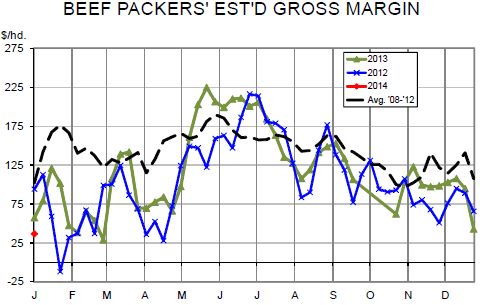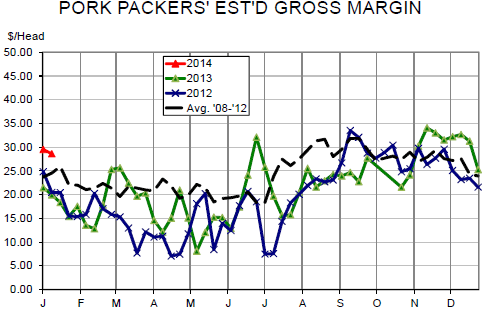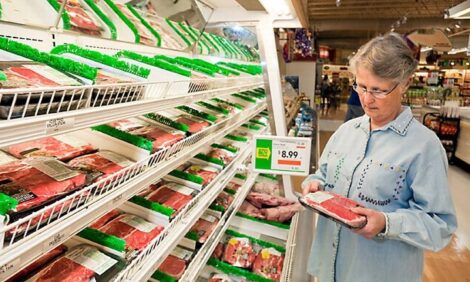



CME: Beef, Pork Take Opposite Turns in Terms of Revenues
US - With record high cutout values, beef packers should be making out alright, right? It’s not quite that clear cut in a margin business that lives and dies off the differences in values as well as its own efficiency, write Steve Meyer and Len Steiner.As can be seen below, gross packer margins that were near the 5-year average in December have plunged in the most recent two weeks for which we have complete data in spite of the cutout value — the major determinant of revenue — hitting record highs.


Before we go on, two items of background information. First, remember that these are gross margins — revenue less cost of goods sold — and not net margins. Packers must still pay all plant, labor, transportation, packaging, etc. from the margins shown here before they arrive at net profits. Second, the piece of data that causes a one week time lag here is the USDA information regarding grading per centage since we use a weighted average of the Choice and Select cutout values in out revenue calculations. Notice that there is not such lag in the pork margin estimates since there is only one cutout used in those calculations.
Some numbers behind the dismal beef situation are:
- Near-record high revenue. We say “near” record-high because the week in question is two weeks ago. Total revenue (weighted average cutout value + by-product value) hit $214.52/ cwt. that week. That is pennies short of revenue the week of 9 November and about roughly $2/cwt lower than a few weekly values last May. Last week’s roughly $10 surge in cutout values will almost certainly result in a new record when the grading per centages become available next week.
- Record-high cattle costs. After weighting live and carcass steer and heifer prices by their respective carcass weights and numbers of heads, average cost for the week of January 4 was $217.04/cwt., meaning packers were in the red on meat value alone. And average cattle costs rose to $222.97/cwt. carcass last week. Comparing that to the increase in cutout value, though, suggests that packers’ gross margins did improve last week even as cattle cost rose. Note that this margin represents a carcass drop level of processing and that packers do earn margins for a number of further processing activities. But we believe those additional margins are more steady and dependable, meaning that the variation you see here goes a long way in determining the variation in packer profitability and thus buying behavior. They are, quite logically, much more interested in processing more animals if they are making money!
- Near record-high by-product values. USDA estimated these to be $14.81/cwt live weight last week or roughly $200 per head. That figure is just off the record of $15.06 (about $203 per head) set in November.
The picture is about opposite for pork packers who have seen lower revenues but also lower hog costs since early last fall. Pork packers had a mixed year in 2013 with relatively strong margins in the spring and again in mid-summer when cutout values finally rallied and by-product values broke above $24/head and approached previous record highs.
But the above-average margins were short-lived and companies spent most of the year seeing below-average results. Those were especially disappointing from August into early fall when packer margins are often at their highest. Good times returned in the fall — as they frequently do — when hog numbers rose and “meat margins” (simply the difference between the cutout value and hog costs) got back to about $10 per head.
We should note that, in order to accurately compare to historical values, the calculations shown above use a -$3.50/cwt. adjustment to the FOB plant cutout value beginning in January 2013 when mandatory price reporting for wholesale pork began. As many readers realize, the change has made historical comparisons a bit challenging.








